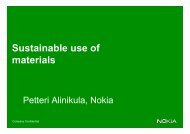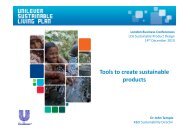Marcus Stutz, Dell - LCA Sustainable Product Design Europe 2010
Marcus Stutz, Dell - LCA Sustainable Product Design Europe 2010
Marcus Stutz, Dell - LCA Sustainable Product Design Europe 2010
Create successful ePaper yourself
Turn your PDF publications into a flip-book with our unique Google optimized e-Paper software.
Using High Quality <strong>LCA</strong> Data to<br />
Make Solid Decisions<br />
Markus <strong>Stutz</strong><br />
EMEA Environmental Affairs Manager
Some Preliminary Remarks<br />
• Any <strong>LCA</strong> is better than no <strong>LCA</strong><br />
– Do not use data issue as excuse<br />
• Using your <strong>LCA</strong> results to take decision already huge step<br />
– Now mostly reporting<br />
– Sometimes discussions about <strong>LCA</strong> results/data resemble “fight the<br />
problem” behavior<br />
• Relying on bad data can lead to “wrong” decisions<br />
– Actions might not be most effective, however still better than doing<br />
nothing<br />
• Good data do not guaranteed good decisions<br />
– Other factors might prevail (cost, customer requirements, technical<br />
features)
Top Level Assessments-Determining Hot Spots<br />
• Ideal to:<br />
– Determine top impacts<br />
– Identify low hanging fruits to improve product/process<br />
– Calculate if a simple change can bring significant improvements<br />
• Two data streams<br />
– Primary (foreground) data<br />
– Secondary (background) data<br />
• Primary (foreground) data<br />
– Bill of materials, logistics, usage patterns<br />
– Assumptions can lead to significantly different results<br />
– Most errors happen with foreground data (personal feeling)<br />
• Secondary (background) data<br />
– <strong>LCA</strong> data for materials & processes<br />
– Totally OK to rely on generic data for top level assessment<br />
– Databases available are e.g. Ecoinvent, GaBi, SimaPro
Making Solid Top Level Decisions<br />
• Only pick a hot spot when impact is contributing over 10% to<br />
total result<br />
• Scenario analysis:<br />
– Assume error margins of +/- 20% (or more)<br />
– What happens if key assumptions change slightly?<br />
› Usage time, charger plugged/unplugged 24/7 etc.<br />
– If results still indicate same hot spots: Results are robust<br />
• Compare with other studies if trend is in the same direction
Results Desktop PCF (Total Life Cycle)<br />
Hotspot #1: Use<br />
Hotspot #3<br />
(AUS only):<br />
Air transport<br />
Hotspot #2: Component Manufacturing
Results and Decisions<br />
• Use is dominating total impact (80%)<br />
– Actions taken to make products more energy efficient clearly<br />
mandated<br />
– More uniform use of power management advised<br />
› Needs user education & training (!)<br />
– Actions already underway: Energy Star, Energy Smart<br />
• Component manufacturing<br />
– Analysis shows that impact dominated by motherboard and chassis<br />
– Making both smaller (e.g. by choosing small form factor) already reduces<br />
impact<br />
– Initiate cooperation with supplier (if willing/interested)<br />
• Regional assembly or transport by ship, if lead time allows, is a<br />
preferable logistics option
How Did Data Quality Affect Decisions?<br />
• More detailed data would not have yielded in other decisions<br />
• Energy consumption in use, manufacturing of steel chassis and<br />
motherboard laminate as well as logistics are all fairly generic<br />
and well analyzed process with good <strong>LCA</strong> data and also with no<br />
huge difference from supplier to supplier (if in same country)<br />
• Assumptions on use and logistics have far greater impact than<br />
variations in data for materials and processes
Detailed Assessments<br />
• Comes only after top level assessment<br />
• Ideal to:<br />
– Decide between design/technical options<br />
• Is only one factor in a set of assessment (e.g. cost, availability, yield,<br />
delivery, features)<br />
• Also here two data streams<br />
– Primary (foreground) data<br />
› Bill of materials, logistics, usage patterns<br />
– Secondary (background) data<br />
› <strong>LCA</strong> data for materials & processes<br />
• Using generic databases for secondary data still ok, if materials/processes<br />
are fairly generic (plastic, painting, etc.)<br />
• For “non standardized” materials/processes (e.g. bamboo packaging)<br />
collecting data strongly suggested
Result PCF Notebook Housing (LCD Cover)
Results and Decisions<br />
• Mg cover clearly highest impacts by far (more than 3x)<br />
• Plastic, steel, Al housing comparable<br />
• Digging deeper:<br />
– Plastic, steel have high (air) transport impact => could be lowered<br />
– Al could be made out of recycled material => impact could be lowered<br />
• Decisions/<br />
– Environmental guys: Plastic or steel<br />
– Marketing guys: Al (follow Apples lead - recyclable)<br />
– Engineering guys: Mg<br />
– Who won?
Housing: The Big Picture<br />
In the big picture any decision on the housing material seems not so relevant …
How Did Data Quality Affect Decisions?<br />
• More detailed data would not have yielded in other decisions<br />
• Manufacturing of Mg, Al, plastic, and steel housing, surface<br />
coating as well as logistics are all fairly generic and well<br />
analyzed processes with good <strong>LCA</strong> data<br />
• Potentially there could be differences from supplier to supplier<br />
– Yield (!)<br />
– Energy mix (country specific!)<br />
– Processes, e.g. clean rooms for painting<br />
– Transport route (local suppliers avoid air transport)<br />
• More detailed data could have helped suppliers in choosing<br />
better processes<br />
• Would it have made sense?
Conclusions<br />
• Carry out <strong>LCA</strong> or PCF studies<br />
• Make/propose decisions based on <strong>LCA</strong>/PCF results<br />
• Pay attention to primary (foreground) data/assumptions<br />
• In most cases generic secondary (background) data is good<br />
enough for standard materials and processes<br />
• Be careful when looking at unique materials and processes<br />
– Data collection at supplier could be advised
Thank you<br />
markus_stutz@dell.com







